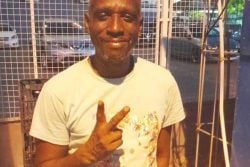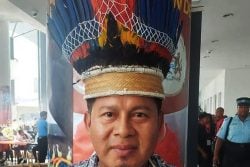A monument expresses the collective goals, joys and sorrows of society. They are as varied as their creators and are regarded as masterpieces of architecture worthy of preservation for future generations.
A commemorative monument can be defined as any object or structure raised in honour of a distinguished persona or to signify the specific site or an event of importance to the history of a country. In Guyana examples of such monuments include the following.
The Cenotaph, located opposite the Bank of Guyana, at the southern end of Main Street, Georgetown, stands as a memorial to all Guyanese soldiers who died in service during the two World Wars 1914-1918 and 1939-1945. On 14 August 1923, on the ninth anniversary of the declaration of war with Germany, British Colonial Governor, Graeme Thompson unveiled this war memorial, which was funded through government subscription.
At the unveiling ceremony, the hope was expressed that “the Cenotaph would be the most honoured of memorials in the city, one which will be regarded by posterity with reverence and respect and which will keep green the memories of the valuable lives this colony sacrificed for a just and righteous cause.”
Built of marble, the cenotaph stands 4.5 m high. Inscribed on the four faces of the monument are the words: Devotion, Humanity, Fortitude and Sacrifice. Annually state officials and other dignitaries honour the nation’s fallen heroes by laying wreaths on Armistice Day.
The mausoleum, located at the Place of the Seven Ponds, The National Shrine for Guyana’s Heroes, in the Botanical Gardens, the final resting place of the former President of Guyana, Linden Forbes Sampson Burnham is another example of a commemorative monument erected in honour of one of the nation’s founder leaders. This monument built of reinforced concrete and local materials, in 1986, was designed by the renowned Guyanese architect Mr. George Henry.
It was described by the architect as having the shape of a crucifix when viewed from above. The roof of the monument was originally covered with wooden shingles, while decorative clay works by Leila Locke, fired at Vanceram grace the entablature of the four faces of the cruciform.
The floor of this monument is made from granite from the Upper Essequibo and Mazaruni regions while the tomb of President Burnham which rests in the centre of this open sided structure has a top which is brush finished with jasper, mainly from the Orinduik area.
The sides of the tomb are decorated with glass briquettes manufactured from Guyana’s sand and produced at the glass factory. It rests on a base of sculptured greenheart that sits on a plinth from the Upper Mazaruni.
The eastern face of the tomb carries a bronze plaque L.F.S. Burnham O.E. S.C. 1923-1985 while the western face carries a plaque of the motif of the standard used by President Burnham. Inside the structure, the two notable figures are the large bronze panels which were designed by Lieutenant Ivor Thom. The panel on the wall illustrates different aspects of the life of President Burnham in the 1960s, whilst the second reflects Burnham’s organization and involvement in social welfare of youths in Guyana and the subsequent establishment of the Guyana National Service.
Located along the northern boundary of the village at Port Mourant, close to the Atlantic Ocean is the Babu John cremation site. After the close of the First World War in 1918 the residents of this plantation were affected by a severe outbreak of influenza. The plantation’s cemetery was soon overcrowded and the administrative manager, Mr. James C Gibson, together with an attorney for the estate decided to establish a new cemetery for the residents at Port Mourant.
Babu Jan, a popular cane planter from De Keneren, East Coast Demerara, was appointed as the caretaker for the new cemetery by the administrative manager. After he died the cemetery became known as the Babu John Cemetery. On 12 March 1997, a mammoth gathering of mourners witnessed the cremation of President Cheddi Bharat Jagan at the Babu Crematorium site. In 2004, a monument adorned with plaques bearing messages from the Office of the President, the People’s Progressive Party and the Cheddi Jagan Research Centre, was unveiled before a large crowd by former President Mrs Janet Jagan.
Located amongst lush green foliage and tropical flora on the Merriman Mall is the Indian Immigration Monument. Sculpted of bronze, this monument, which rests on a black granite pedestal, is a replica of the Whitby, the ship that transported the first batch of Indian immigrants to the shore of Guyana on 5 May 1838.
Indentureship, which lasted until 1917, was described by Chief Justice Beaumont in 1871, ‘as a monstrous system rooted in slavery.’ In 1987 a committee was established along with the National Commemoration Commission to formulate plans to celebrate the 150th anniversary of the arrival of Indians to Guyana. On 5 May 1988, this event was celebrated with much fanfare and gala.
After the celebrations it was decided that a monument in honour of the Indian immigrants should be erected. The Committee enthusiastically endorsed this proposal and the quest for a suitable site commenced. Several sites including the small grass oval where the Marine Turtle Conservation Monument now stands and the reserve between Water Street and Battery Road were among the areas identified. However these were not deemed appropriate and the search continued.
On 11 October 1989, Mrs Viola Burnham, Vice President for Culture and Social Development, formally recommended that the Commission seek permission from the City Council for the use of the monument’s present location on the Merriman Mall to erect this monument. In February 1990, this was done and in June of that year the proposal was endorsed.
On 5 May 1991, the first commemoration ceremony took place under a tree at the western end of the monument’s complex. In April 1992, a national design competition was launched. At the close of the competition Mr. Roopak Kothari, an architect from India, visited Guyana from 1-6 May 1992 and together with Mr. Albert Rodrigues and a select panel judged the entries submitted.
Many themes were submitted but it was the idea of a ship representing the immigrant’s journey to Guyana that was selected by the Committee. Armed with the proposal for the design of the monument and its garden, the Committee approached the Indian High Commissioner, Mr. Ramiah Rajagopalan for assistance to erect this monument.
In March 1993, the structural works and the landscaping of the gardens commenced and in August 1996, the bronze sculpture of the Whitby, designed by Mr. Balkishen K. Guru, an Indian national, arrived in Guyana. This commendable work of art was unveiled by Mr. Yesu Persaud, the Chairman of the Committee on 5 May 1997.
The Damon Monument, located at Anna Regina on the Essequibo Coast, is another example of a monument erected in honour of one of Guyana’s noteworthy personas. Damon, an enslaved domestic African, was executed for his role in the protest against a new system of apprenticeship.
On 3 August 1834, the labourers went on strike declaring that they were free and would only work for half day. Damon, who was their leader, raised a flag in the Trinity Church yard at La Belle Alliance, which they had occupied during their protest. He was hanged at the Parliament Building at noon on Monday 13 October 1834.
The proposal for the erection of a monument to honour the fallen hero, Damon, came from the Guyana Commemoration Commis-sion in 1985. Mr. Ivor Thom, a lieutenant of the Guyana National Service sculpted this impressive monument, which was cast at the Brass Aluminium and Cast Iron Foundry.
Located in the eastern end of the compound of Parliament Buildings is another monument erected to another great Guyanese Hubert Nathaniel Critchlow, the pioneer of the trade union movement in Guyana.
On 21 February 1964, opposition leader of the People’s Na
tional Congress, Linden Forbes Sampson Burnham, proposed to parliament that the government should erect a statue to the great pioneer of labour, the late Hubert Nathaniel Critchlow. This proposal was endorsed and the necessary preparations were made to allow for its timely completion. The decision to place the monuments in the compound of the Parliament Buildings was not without controversy. It was suggested that a more fitting location would be the Bourda Green where Critchlow had delivered many of his most memorable speeches.
On 2 December 1964, this bronze statue, sculpted to the likeness of Critchlow by Mr. E R Burrowes, with assistance from Walter Milling and Andrew Lyght, was unveiled by the then Premier of British Guiana, Dr. Cheddi Jagan.
Erected to commemorate the most significant event in the nation’s history, the birth of sovereignty is the Brickdam Independence Arch. On 22 May 1966 Prime Minister Linden Forbes Sampson Burnham was formally presented by the Managing Director of the Demerara Bauxite Company, Mr. J G Campbell, with the Brickdam Independence Arch, a gift to the people of Guyana in recognition of political independence.
In his presentation, Mr. Campbell noted that the arch which was designed by a Canadian architect, Mr. Edric Flack, could be described as truly Guyanese built of materials that would endure time and elements, namely aluminum that was made from the bauxite from Mackenzie. Mr. Aubrey Barker, the chairman of the Arch Committee noted that there were two factors which influenced the selection of the site. The first was the proposal to build a civic and cultural centre along D’Urban backlands and the second was that Brickdam, was the garden city’s oldest street. In the circumstance the monument would link the past and the future.
There are many other monuments that were erected in the course of the nation’s history during the colonial era and after the attainment of independence, each defined by distinct events or occurrences. In future articles other commemorative monuments will be examined.





